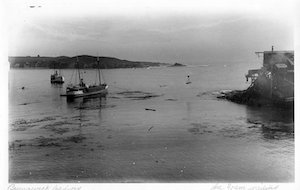
The Steamer “Brunswick” being loaded with a wire chute at the Mendocino Headlands and the Sea Foam waiting to come in. (Gift of Emery Escola)
March 28, 1902 – The wire chute at the Shipping Point was used for the first time to transfer lumber to a waiting ship. Jerome C. Ford supervised the installation. Previously, lumber was transferred to a ship by lighter or by apron chute (also called slide or gravity chute).
During the previous decade, wire chutes had been installed at almost every shipping place along the Mendocino Coast, including nearby ones at Little River and Russian Gulch. Lacking a wire chute had put Mendocino at a competitive disadvantage. Many of the ship owners had frequently expressed a dislike for loading at Mendocino due to the extra time required to load cargo. In March 1901, Superintendent Ford told the Beacon that the shipping facilities at the Point were inadequate. “The wire chute is to be put in just south of the slide chute in use at present. The latter is not to be torn down, but will be kept for loading schooners. The wire chute will enable steamers to lie at the moorings in the bay while being loaded.”
“John F. Peterson built the wire chute at the shipping point in Mendocino to load lumber onto ships in the harbor. When the Panama Canal was being built a great deal of lumber was shipped from Mendocino. At first it was sent down wooden apron chutes to be loaded on small lumber schooners bound for San Francisco. There, lumber had to be transferred to a larger more seaworthy vessel for the rest of the journey to Panama. This not only caused delay but added to the shipping expense. Peterson figured out how the larger vessels could stand farther offshore in deep water and be loaded by means of a wire cable which was fastened at the loading platform on the bluff at the point and stretched out over the vessel and anchored beyond it. Then the lumber could be lowered in a sling hanging from a traveler on a pulley riding on the cable. A steam engine operated at the loading platform controlled the traveler.” (from The Biography of John Frederick Peterson). John was the brother of Little River shipbuilder Thomas Petersen.
Following the installation of the wire chute, the Beacon reported, “The new chute is said to be superior to anything else of the kind on the coast, and, while it cannot be said to be a thing of beauty, it is to be hoped that it will be a joy forever. In fact the question of speed in loading is now up to the steamer crew, as lumber can be put aboard much faster than the crew on the steamer can handle it.”
“Thomas H. Petersen Master Shipbuilder” by Louis A. Hough. Thomas Petersen built about three dozen wooden vessels: sailing schooners, a barkentine, steam schooners, steam tugs and lighters. Based on Petersen’s memoirs. $15.